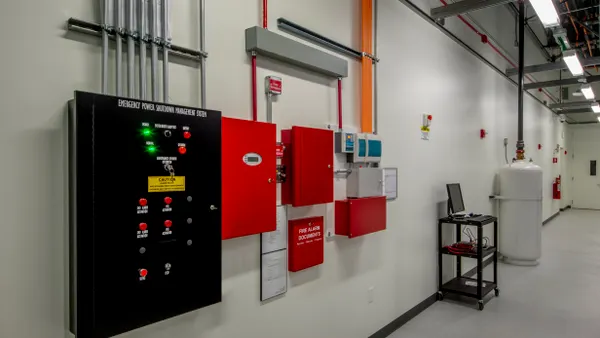Last October, JLL launched Falcon, a platform that combines the company’s proprietary data with generative AI models to deliver what it said was revenue-generating, cost-savings insights to its team members and clients.
“With JLL Falcon, our clients can focus on the benefits AI brings to their business, while we handle the complexities of building and deploying AI,” Yao Morin, the company’s chief technology officer, said at the time.

By using the platform for things like image recognition, data modeling and text generation, facilities managers could, among other things, optimize an estimated 65% of their asset improvement-related tasks, the company said.
A big challenge, though, is finding and training technicians to use this or any other AI tool the right way.
To learn more about JLL’s efforts and the broader challenge of using AI for facilities management, Facilities Dive sat down with Yao Morin.
The interview has been edited for length and clarity.
FACILITIES DIVE: How can AI boost existing technologies?
YAO MORIN: The first thing I think about is that it provides a much more user-friendly interface than what has been the case with technology. It takes away a lot of the unnatural interaction between humans and technology.
Secondly, it unlocks a large number of use cases that traditionally have been difficult with technology, including things that have to do with unstructured data, long documents, long websites, search and entity resolution. Now you can manage those things more easily. [Entity resolution refers to the ability to link data from different sources to a single entity.]
A lot of our data is contained in long documents, such as contracts. The new large language model technology is making it easier to process and extract information from the unstructured data in these long documents.
Another challenge that's quite specific to commercial real estate is the lack of a standard ID for property. For example, a U.S. person has a Social Security Number that is unique to that person, and then everything can link to the number or the person’s driver’s license number. But in commercial real estate, we don’t have a standard ID for a property or a standard listing. This makes all of the commercial real estate data very disparate, because there is not an easy way to connect all the data together.
There can be multiple street addresses in the same building. How do you link all those up? We’re trying to leverage AI to do better data linkage – to reason through different data points to say, ‘Oh, this address is the same as that address,’ or ‘This space is actually part of this particular building.’ It’s not just addresses. Some buildings have names. How do you know this name is linked to that address?
The third is agentic AI, where AI is not just answering questions or processing data, but actually taking actions for you to get to that last mile. [As with driving], AI used to just navigate for you, but now it can drive for you. You will see more AI taking steps for you, and that’s a huge booster for existing technology.
Lastly is computer vision. In commercial real estate and facility management, the power of image recognition is so much higher now, so it can be used to help prevent accidents, report accidents and other facility issues. It can help people be more efficient in carrying out service delivery tasks. Computer vision and the field stuff is going to be a very big AI trend in my mind.
How does JLL differentiate its AI efforts from competitors?
We are very intentional in terms of the technology we built and the talent we recruit. We try to recruit technology talent that is more in the forefront of how technologies are being developed. We also bring a lot of this work in-house. We believe that for some of this technology and some of the applications that we are building, the data is so crucial that we need to do it in-house.
A lot of the traditional commercial real estate companies develop technologies with the outsource model. We want to build and control the data. We want to protect our data. We want to make sure we build our own secret sauce, so we can stand out from a brokerage perspective and facilities management perspective, and our competitors cannot just copy or license [our approach].
Where does JLL stand on AI adoption?
With Falcon and some of the other technical capabilities we have put out, we have built a lot of amazing product features across our entire tech stack. We’ve been experimenting and have a beta on a facility management agent for our clients. There are about 60 new features that are either already released or on the way.
You need to put out something that people find useful, so they are willing to use it. [To this end], we relentlessly do two things. One is training people how to use all these applications. A lot of people [who develop these applications] come from tech, especially consumer tech, and [don’t keep the user in mind]. ‘I put our app out there, and then people will figure out how to use it.’ But in enterprise, in a company like this, where there are people from all kinds of backgrounds and people with very different degrees of familiarity with AI, training is so important.
Last year, we spent a lot of time training our employees on AI. We trained around 20,000 employees on how to use AI and that is not by accident. It was a very dedicated effort, because we know how important it is to actually help employees get comfortable with AI and really realize what it can do. You see a lot of creativity coming out of it, because we actually see a lot of our employees being innovative and coming up with use cases without us even thinking about it, like, ‘Oh, you can do it this way too.’
So we’re relentlessly training our employees, tracking the training metrics and relentlessly tracking adoption, so we can continue to push toward a very aggressive adoption goal.
I can't say enough to other companies who are struggling to help their employees adopt AI. You have to spend the resources to help them understand the power of AI and then the limitation of it as well.












